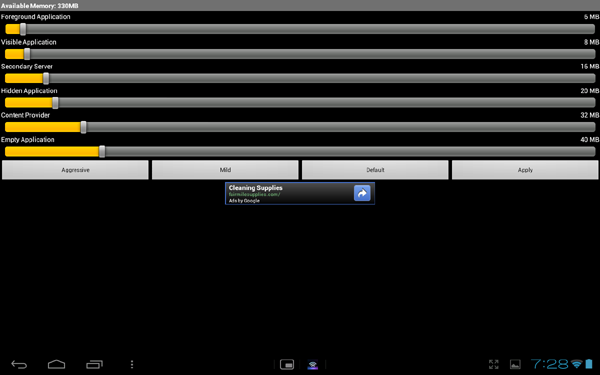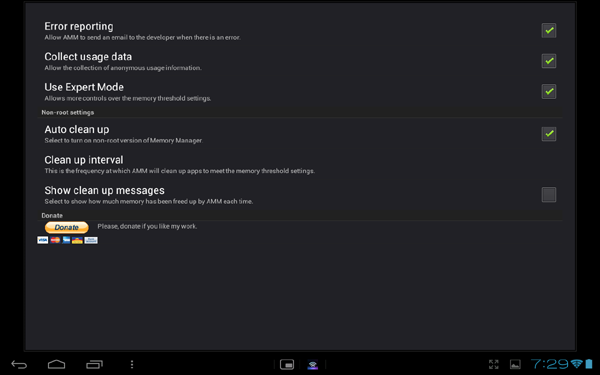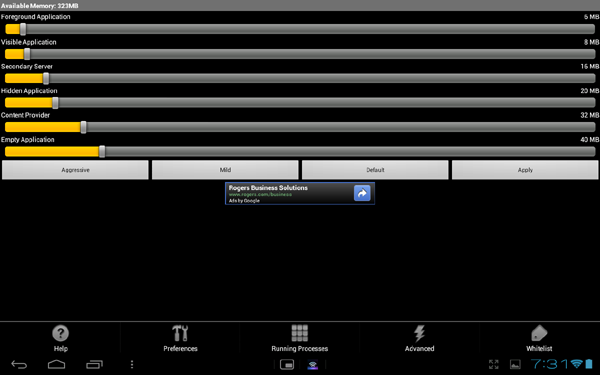Even though we’re seeing an increasing push toward faster processors with more cores, smartphones and tablets are still limited by the amount of RAM they have under the hood. One of the biggest reasons why your Android smartphone might feel sluggish isn’t because the processor isn’t holding up its part of the bargain; it could be because you’re simply running out of memory. This is because the Google Android platform has a habit of keeping processes running in the background and — even if they’re not active — they hog up some of that precious memory. The rationale is that when you do return to a previously opened app, it’s the same as when you left it, making for a more seamless user experience. But, that could come at the price of decreased overall performance.
One way to tackle this is an app called Auto Memory Manager. The ad-supported version is a free download from the Google Play Store, or you can pony up $1.49 for the paid version and get rid of the ads. The idea here is relatively simple, but it can be remarkably effective. It works as an automatic task manager.
Killing Background Processes
Yes, Android 4.0 Ice Cream Sandwich comes with a built-in task manager that’s a lot easier to use than previous versions of Google’s mobile operating system, but it’s still not up to snuff. The problem is that you still need to go in manually to “kill” dormant tasks so that you can free up that memory for active tasks.

With Auto Memory Manager, this process is automated. It monitors how much memory is currently in use and when the available memory falls behind user-defined thresholds, the app will then automatically go in and start closing background apps and processes on a priority basis. The net result is that you get more RAM and, thus, your session of Angry Birds Space is less likely to crash on you.
Six Types of Apps and Processes
Instead of reserving a set amount of memory for certain apps or app types, the process with Auto Memory Manager looks at certain thresholds of available memory. These thresholds are set for six different types of apps and processes, killing off those applications when the thresholds are met.
- Foreground Application: These are apps that you currently see on the screen, including System and Phone.
- Visible Application: Apps that are visible, but not at the front because of transparency or other factors. Live wallpapers fall under this category.
- Secondary Server: These are apps that run in the background, like GUI customizations (TouchWiz, Sense UI) and Launcher (Home).
- Hidden Applications: Apps that are running in the background and are not visible, like your Twitter client.
- Content Provider: Processors that provide content for others, like the Contacts content provider.
- Empty Application: Apps that are dormant and are not currently doing any work. These can be safely closed at any time.
In the case of the Sony Tablet S that I used to review this app, I officially have 1GB of RAM, of which about 740MB is available to the user. If I set the threshold on the Empty Application to 100MB, this means that when the available memory falls below 100MB, Auto Memory Manager will start closing apps and processes that fall under that category, while leaving the other five categories alone (assuming that their thresholds are lower).
As you can see from the first screenshot at the top, each of the six categories has its own slider. This way, you can adjust the settings as you see fit. Alternatively, there are three quick settings at the bottom: aggressive (sets the thresholds relatively higher), mild (sets the thresholds relatively lower) and default. It’s up to you how much you want to tweak your settings, but remember to tap on “Apply” when you’re done.

Going into the settings of Auto Memory Manager, you have the option to see your running processes. These can be listed normally, grouped by app lifecycle (the six categories shown above), grouped by OOM grouping (more on this in a bit), and services. This way, you can see what apps are using the most memory at any given time.
More Settings and Options
OOM grouping refers to Out of Memory. You can set the relative priority of each individual app, process and service. This ranges from -16 for the highest priority, up to +15 for the lowest priority. This way, even though Auto Memory Manager is automatically closing apps and processes based on the six categories, it can prioritize within those categories which you’d prefer to keep open and which you’d prefer it to close first.

You can also go into the settings for a few more adjustments. You can opt in or out of error reporting and anonymous usage data collection, for example, as well as adjust the interval for when Auto Memory Manager will close. This ranges from every minute to every hour. Naturally, having it do its “clean up” sweep every minute will likely have a detrimental effect on your battery life, but it means that your device should be running at its best all the time.
Seamless Performance Booster

It’s hard to say exactly how much faster or more responsive your Android device will be with Auto Memory Manager, but assuming that everything works the way that it’s supposed to work, you really have nothing to lose. The app clean up processes and apps that aren’t as important, so that your current apps can run more smoothly and with fewer crashes. That sounds pretty good to me.
Head over to the Google Play Store to find Auto Memory Manager by Mad Squirrel. It’s not as hands-on as a manual task killer, but it is assuredly much smarter.
Michael Kwan is a published author, freelance writer and professional gadget geek. He blogs six times a week at Beyond the Rhetoric, and yes, he can write for you too.



